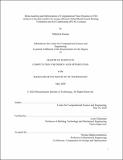| dc.contributor.advisor | Leon Glicksman. | en_US |
| dc.contributor.author | Ghanta, Nikhilesh. | en_US |
| dc.contributor.other | Massachusetts Institute of Technology. Computation for Design and Optimization Program. | en_US |
| dc.date.accessioned | 2020-09-03T16:48:02Z | |
| dc.date.available | 2020-09-03T16:48:02Z | |
| dc.date.copyright | 2020 | en_US |
| dc.date.issued | 2020 | en_US |
| dc.identifier.uri | https://hdl.handle.net/1721.1/126989 | |
| dc.description | Thesis: S.M., Massachusetts Institute of Technology, Computation for Design and Optimization Program, May, 2020 | en_US |
| dc.description | Cataloged from the official PDF of thesis. | en_US |
| dc.description | Includes bibliographical references (pages 172-178). | en_US |
| dc.description.abstract | With the rapid rise in the use of air conditioning systems and technological advancements, there is an ever-increasing need for optimizing the HVAC systems for energy efficiency while maintaining adequate occupant thermal comfort. HVAC systems in buildings alone contribute to almost 15% of the overall energy consumption across all sectors in the world and optimizing this would contribute positively towards overcoming climate change and reducing the global carbon footprint. A relatively modern solution is to implement a smart building-based control system and one of the objectives of this study is to understand the physical phenomenon associated with workspaces conditioned by chilled beams and evaluated the methods to reduce energy consumption. | en_US |
| dc.description.abstract | Building upon the initial work aimed at creating a workflow for a smart building, this thesis presents the results of both experimental and computational studies of occupant thermal comfort with chilled beams (primarily in conference rooms) and the various inefficiencies associated. Results from these studies have helped to inform an optimum location for the installation of a chilled beam to counter the effects of incoming solar irradiation through an external window while keeping the energy consumption low. A detailed understanding of the various parameters influencing the temperature distribution in a room with chilled beams is achieved using CFD studies and data analysis of experimental data logging. | en_US |
| dc.description.abstract | The work converges into a fundamental question of where, how, and what to measure to best monitor and control the human thermal comfort, and a novel technique was presented using the existing sensors which would provide a significant improvement over other existing methods in practice. This technique was validated using a series of experiments. The thesis concludes by presenting early works on hybrid HVAC systems including chilled beams and ceiling fans for higher economic gains. Future work should seek to perform CFD simulations for a better understanding of hybrid HVAC systems, both in conference rooms and open-plan office spaces, and also to design a new sensor that could better estimate human thermal comfort. | en_US |
| dc.description.statementofresponsibility | by Nikhilesh Ghanta. | en_US |
| dc.format.extent | 178 pages | en_US |
| dc.language.iso | eng | en_US |
| dc.publisher | Massachusetts Institute of Technology | en_US |
| dc.rights | MIT theses may be protected by copyright. Please reuse MIT thesis content according to the MIT Libraries Permissions Policy, which is available through the URL provided. | en_US |
| dc.rights.uri | http://dspace.mit.edu/handle/1721.1/7582 | en_US |
| dc.subject | Computation for Design and Optimization Program. | en_US |
| dc.title | Meta-modeling and Optimization of Computational Fluid Dynamics (CFD) analysis in thermal comfort for energy-efficient Chilled Beams-based Heating, Ventilation and Air-Conditioning (HVAC) systems | en_US |
| dc.type | Thesis | en_US |
| dc.description.degree | S.M. | en_US |
| dc.contributor.department | Massachusetts Institute of Technology. Computation for Design and Optimization Program | en_US |
| dc.identifier.oclc | 1191229200 | en_US |
| dc.description.collection | S.M. Massachusetts Institute of Technology, Computation for Design and Optimization Program | en_US |
| dspace.imported | 2020-09-03T16:48:02Z | en_US |
| mit.thesis.degree | Master | en_US |
| mit.thesis.department | CDO | en_US |
